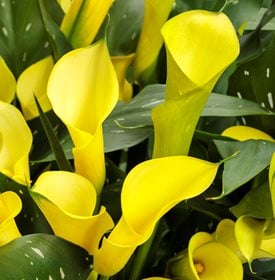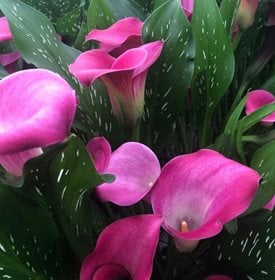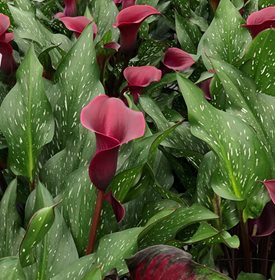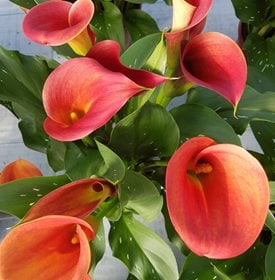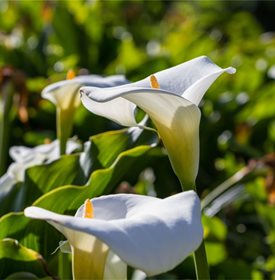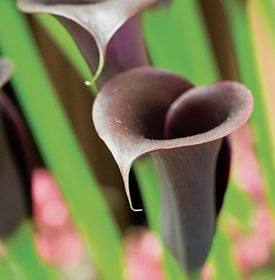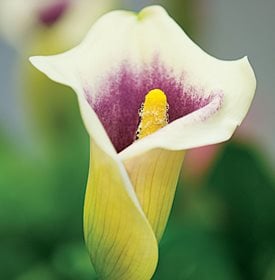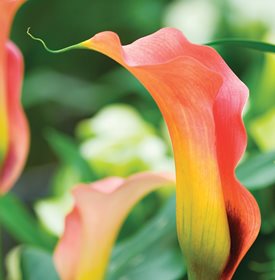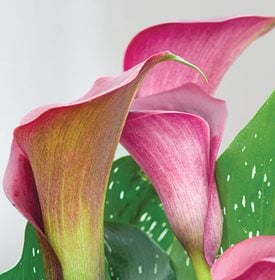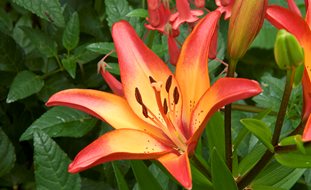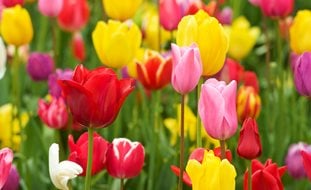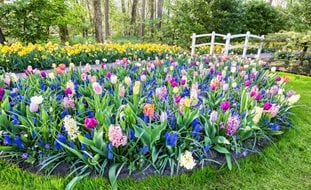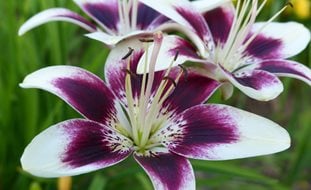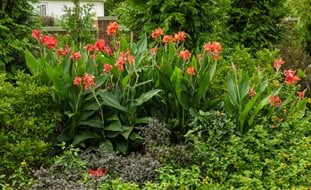Calla Lily Care Guide: How to Grow & Maintain Stunning Blooms
Grow calla lilies successfully with expert planting and care tips. Learn the best ways to keep these vibrant flowers thriving in gardens & containers!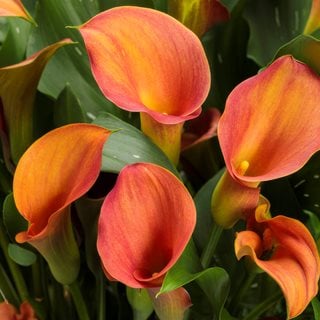
Be My® Main Squeeze™ calla lily (Zantedeschia hybrid). Photo by: Proven Winners
Calla lily flowers have long been a symbol of rebirth and resurrection, and are closely associated with the Easter holiday. In addition to the pure white flowers of the traditional species, modern hybrids come in a wide array of colors. The flowers, also known as spathes, bloom for weeks, adding long-lasting color to containers, borders, mass plantings and cut flower arrangements. Grown from rhizomes, this tropical is also sold in florist shops as a houseplant.
While not true lilies, calla lilies do share many of their qualities—they are sensual, graceful, suggestive, and exotic—leaving many gardeners surprised at how easy growing and caring for these flowers can be.
On this page: Basics | Planting | Care | Pictures | Design Ideas | Growing Indoors | FAQ's
On this page:
- BASICS
- PLANTING CALLA LILIES
- CALLA LILY CARE AND MAINTENANCE
- CALLA LILY VARIETIES
- DESIGN IDEAS
- GROWING CALLA LILIES INDOORS
- FAQ's
BASICS
Botanical name:
Zantedeschia spp. and hybrids
Zones:
Hybrids prefer Zone 9 or warmer, while Z. aethiopica can be grown in Zones 8-10. Grown as an annual in cooler areas.
Height/Spread:
Upright habit; 12 to 36 inches tall, 9 to 24 inches wide
Exposure:
Full sun to partial shade; with bright, indirect light being ideal. Dense shade might put a damper on bud count, and scorching midday summer sun can prove equally challenging.
Bloom time:
Flower stalks appear about eight weeks after planting and bloom for months.
Color and characteristics:
Calla lily is an herbaceous or semi-evergreen perennial grown from rhizomes. Tubular-shaped flowers with pointed tips produce a long, finger-like spadix at the center. Calla lily flowers come in a range of colors, including white, yellow, orange, pink, red, purple, green, and even black. Tall elegant stems rise above broad solid green or speckled leaves.
Are calla lilies poisonous?
Calla lilies are highly dangerous to pets and humans if any part of the plant is ingested. Sap may cause skin or eye irritation. Wear gloves and handle plants carefully. See more: Common Poisonous Plants for Dogs and Cats.
HOW TO PLANT CALLA LILIES

"This is what a calla lily rhizome looks like. You want to plant it with the smooth side facing down and the nubby side (pictured) facing up—those nubby points are the growth points!”
— Laura LeBoutillier of Garden Answer. See more in this video.
When to plant:
Plant your calla outdoors any time between February and June (but after danger of frost is past).
Where to plant:
Choose a sunny to partially shaded site with amended, well-draining soil.
How to plant:
Bury the tuber-like rhizomes 3 to 4 inches deep in porous soil directly in the garden or in containers.
For more on how to plant bulbs:
CALLA LILY CARE
Temperature and humidity:
This tropical plant prefers temperatures between 60 to 80 degrees F. Calla lily thrives in humid and moist conditions and may need protection from hot afternoon sun. Plants will go dormant when temperatures drop below 50 degrees F. Don’t allow rhizomes to freeze.
Soil:
Hybrids prefer a well-drained, porous soil. Sandy soils are good if you add fertilizer; clay soils can be tricky. For containers, use a high-quality, all-purpose potting mix.
Watering:
Water when the soil is slightly dry, but avoid overwatering, as hybrids dislike soggy soil, which can lead to root rot.
Amendments and fertilizer:
Apply a slow-release fertilizer at planting. Too much nitrogen will boost leaves, but sacrifice blooms. Fertile soil needs no extra feeding.
Deadheading:
Cut off spent blooms and remove damaged or discolored leaves to tidy up plants.
Pests and diseases:
Diseases can include bacterial soft rot, botrytis, powdery mildew, gray mold, blight, leaf spot, dasheen mosaic virus, spotted wilt, and armillaria rot. Pests can include slugs, Japanese beetles, aphids, spider mites, or thrips.
Winter care:
Before frost threatens in autumn or early winter:
- Potted callas: Cut the foliage back to the ground once it yellows and bring pots indoors to a cool, dry environment to rest the rhizomes.
- In-ground callas: Cut the foliage back to the ground once it yellows, dig up the rhizomes, and store them in a dry 55ºF environment.
Withhold water for eight weeks or longer before jump-starting the cycle again with light and water.
CALLA LILY PICTURES
YouTube Short by Janey @digplantwaterrepeat
DESIGN IDEAS FOR CALLA LILIES
- Borders & landscapes – Use in mass plantings, mixed borders, or near water features.
- Slopes & hillsides – Plant alone or with ground covers for color and erosion control.
- Containers – Grow in pots indoors or outdoors, alone or with companion plants.
There are many ways to enjoy calla lilies in your home or garden:
- Decorative containers – Pair with other plants on a patio or deck.
- Houseplants – Place near a bright window for year-round beauty.
- Cut flowers – Arrange spathes in a tall vase for an elegant display.
- Mixed borders – Add summer-long color alongside perennials and shrubs.
- Woodland gardens – Plant with ferns, astilbes, and hostas in dappled shade.
- Mass plantings – Underplant with creeping Jenny or bugleweed for contrast.
- Water features – Site near ponds or streams for a lush, tropical effect.
- Cutting gardens – Grow with dahlias and gladiolus for fresh bouquets.
- Floral arrangements – Use calla lilies in wedding bouquets, centerpieces, and corsages.
Companion plants: Plant with dahlias and gladiolus for a cutting garden that will last until frost. Other companions include creeping Jenny, New Guinea impatiens, ferns, and astilbes. For containers, plant alongside warm season annuals such as petunias, dusty miller, heliotrope, or dichondra.

Persimmon container recipe. Photo by: Proven Winners
CALLA LILY CARE INDOORS
If you’ve just received a potted calla lily as a gift, they make wonderful houseplants. Here are a few tips for caring for callas indoors:
- Keep the soil moist, but not soggy
- Provide bright, indirect light
- Apply liquid fertilizer monthly while in flower
- Keep away from heating and A/C vents
- Reduce watering when the plant enters dormancy (November)
- Cut the leaves off at soil level once they’ve died
- Allow callas to rest in a cool, dark area during dormancy
- Repot annually before the growing season
CALLA LILY FAQ'S
Do calla lilies come back every year?
This tender perennial will die down or go semi-evergreen in winter come back from the rhizomes in spring in warmer climates. In areas colder than zone 8, the rhizomes can be dug and stored indoors over winter.
Will calla lilies spread?
Rhizomes will reproduce and spread, and can be dug up and divided every few years, or as needed.
Do calla lilies grow well in pots?
Calla lilies are well-suited to being grown in containers, either by themselves or in combination with other plants. They are also commonly sold as a potted houseplant.
How long do calla lilies bloom?
Calla lilies are long-lasting, with flowers blooming from 6 to 12 weeks, depending on the variety and growing conditions.
Are calla lilies invasive?
Calla lilies may be invasive in parts of California. Seeds are spread by birds, and small pieces of the rhizomes can break off and show up in unwanted places. Learn more: Where is this species invasive in the US?
